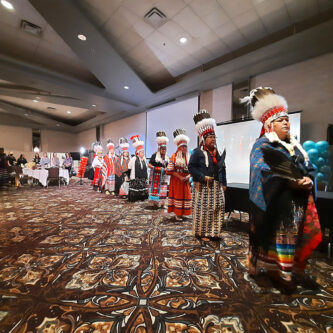Empowerment celebration acknowledges leaders among Blackfoot women
By Tim Kalinowski on July 27, 2021.
 Herald photo by Tim Kalinowski
The women of the Stand Up Headdress Society perform a dance of empowerment and blessing to conclude the Blackfoot Women's Empowerment Celebration at the Coast Hotel on Monday.
Herald photo by Tim Kalinowski
The women of the Stand Up Headdress Society perform a dance of empowerment and blessing to conclude the Blackfoot Women's Empowerment Celebration at the Coast Hotel on Monday.LETHBRIDGE HERALDtkalinowski@lethbridgeherald.com
A Blackfoot women’s empowerment celebration held at the Coast Hotel on Monday highlighted three years of consultation with Blackfoot women in Lethbridge, Calgary, Piikani, Siksika and Kainai to identify common problems and needs, and to strategize on solutions to help address those problems.
The work was done by the Indigenous Women’s Council of the Opokaa’sin Early Intervention Society thanks to a $350,000 grant from the federal government. It included a community needs assessment study, and helped fund a pilot project with the Paahtomasikimi Cultural Centre in Waterton to bring greater awareness and marketing power to Blackfoot women artisans in the region through the construction of a website and online gallery. Another project funded by the grant was the Red Women Talks.
Tanya Pace-Crosschild, director of the Opokaa’sin Early Intervention Society, said some important learnings came out of the needs assessment process.
“The most important thing we are going to take from this project is the power that we as Blackfoot women have in our communities as changemakers,” she said. “Those changemakers and those leaders are grassroots leaders that are already doing a lot of the work in the community.
“I think by taking a strength-based approach to this, and looking at the strength inside the communities, and nurturing, supporting and mentoring, those women who are already doing the hard work in the communities a lot of times these women do not get recognized for the work they do.”
Pace-Crosschild said the needs assessment was a real eye-opening experience for committee members, and revealed the importance of relationships to the success of Blackfoot women in everyday life.
“We talk about going from economic security to prosperity, and a lot of it people think is about money,” she explained. “But really in Indigenous communities, in our communities, it is all about relationships, and how we cultivate those relationships for future generations.”
Pace-Crosschild hoped the report produced from the three-year study would be a catalyst for future directions of empowerment for Blackfoot women.
“It’s a catalyst to get women talking and networking,” she confirmed.
“I think we are doing our own thing in our own bubbles in our different communities. But (this) is really gathering them together. And what a wonderful time post-pandemic to come together and to really share and network.”
While the pilot projects looked at various aspects of what empowerment might mean from an Indigenous perspective, said Crystal Good Rider, the project co-ordinator for Blackfoot women’s empowerment with the Indigenous Women’s Council, it also certainly includes pathways to greater economic success and prosperity which stay true to the Blackfoot way.
“I think empowerment in a Blackfoot sense is really encouraging everyone to become their own leader for their communities,” she said. “A long time ago everyone had a role to play, whether you were a beader or a seamstress, everyone had a role to play. So I think it is really trying to empower those women and help one another learn skills that can help them make a living.”
A strong representation of that spirit of traditional empowerment presented during Monday’s celebrations were the White Buffalo Singers, a group of young women who have formed the first all girls drumming and singing group in the region.
“I feel like when we go out to perform and sing it encourages other young girls to go out there, go out of their comfort zone, to go be themselves and just do what they like and they enjoy,” said group co-founder Doricia Healy. “Going out there just shows we don’t have to hide it and we don’t have to be scared to show who we are.”
After a day of presentations and messages of women’s empowerment, the event ended with a powerful processional dance from the women of the Stand Up Headdress Society (Kaamiipoisaamiks). The dance was intended to call on the spirits of the departed Blackfoot grandmothers to give blessings for the women of today as they take on the social challenges and needs of their communities.
Follow @TimKalHerald on Twitter
Follow @TimKalHerald on Twitter
4-3


